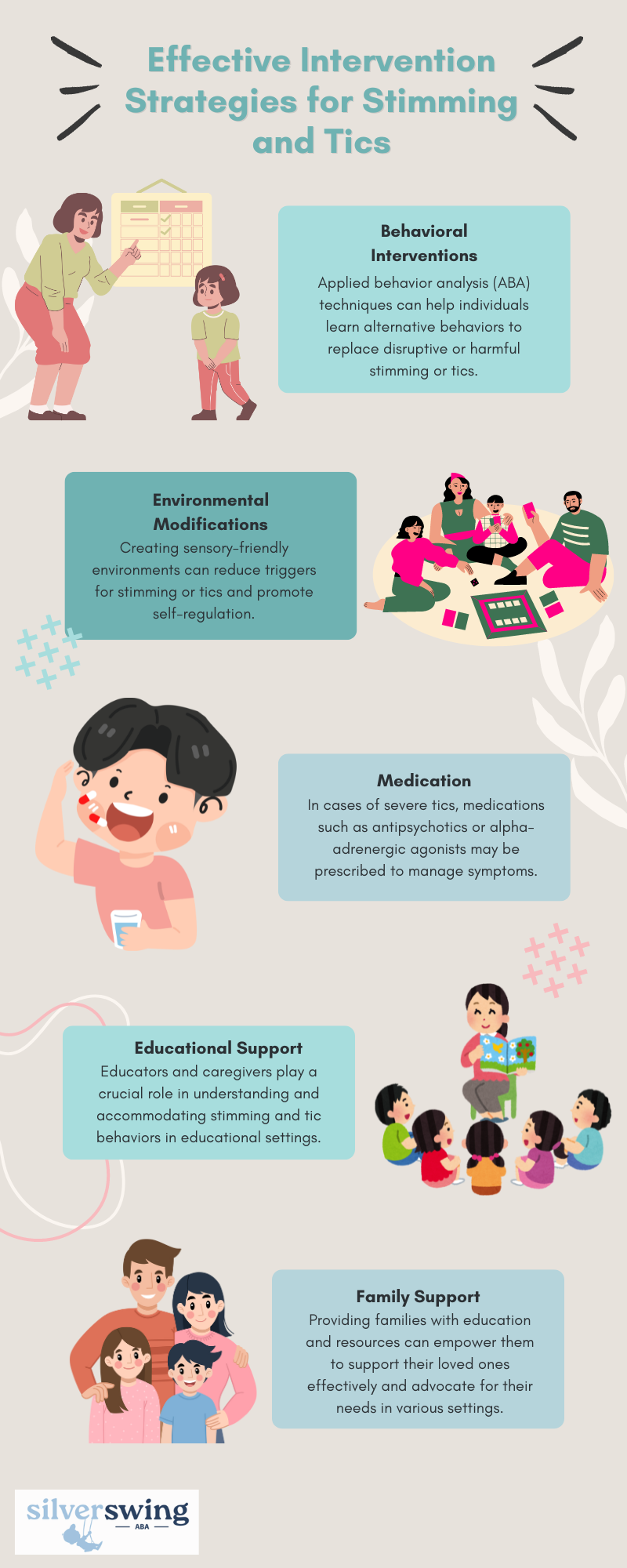Stimming and tics are behaviors observed in individuals with neurodevelopmental conditions, but they have distinct characteristics and underlying reasons. Understanding these differences is crucial for providing appropriate support and fostering acceptance.

What is Stimming?
Stimming refers to repetitive movements, sounds, or actions that individuals engage in to self-soothe, regulate sensory input, or express excitement. It is commonly seen in autism spectrum disorders (ASD) and other neurological conditions. Some notable examples include hand-flapping, rocking, spinning objects, or making repetitive sounds.
Stimming serves to regulate sensory experiences and emotions. It can help individuals manage sensory overload or express emotions like happiness. For instance, a person with autism may flap their hands in response to excitement or to modulate overwhelming sensory stimuli in their environment.
Stimming behaviors vary widely among individuals and can be comforting and reassuring for those who engage in them.

Functions of Stimming
There are several functions of stimming in individuals with autism as research suggests. These are as follows::
- Sensory Regulation – Stimming helps individuals regulate sensory input, reducing discomfort from sensory overload or seeking additional sensory stimulation when needed.
- Emotional Expression – It serves as a way to express emotions that are otherwise challenging to communicate verbally, such as excitement, frustration, or anxiety.
- Self-Soothing – Stimming behaviors can act as self-soothing mechanisms in stressful situations, providing a sense of control and comfort.
Understanding the functions of stimming can provide insights into the individual’s sensory and emotional experiences, facilitating better support and interventions tailored to their needs.

What are Tics?
On the other hand, tics are sudden, repetitive movements or vocalizations that are involuntary and difficult to control. They are not driven by sensory needs or emotions but rather by internal urges or sensations. Tics are associated with Tourette syndrome and other tic disorders.
Some examples include eye blinking, facial grimacing, throat clearing, or repeating words.
Tics provide temporary relief from premonitory sensations but serve no practical purpose beyond that. Individuals with tics may experience varying levels of awareness or discomfort associated with their tic behaviors. The severity and frequency of tics can fluctuate over time, influenced by factors such as stress, fatigue, or excitement.
Tics can be categorized into two main types:
- Motor Tics – Involving movements of the body, such as eye blinking, head jerking, or limb movements.
- Vocal Tics – Involving sounds or words, such as throat clearing, grunting, or repeating phrases.
Some individuals may experience both motor and vocal tics, while others may predominantly have one type. The diversity of tics underscores the complexity of Tourette syndrome and related conditions.

Key Differences Between Stimming and Tics
Stimming and tics differ fundamentally in their nature and underlying purposes. Stimming, observed primarily in individuals with autism spectrum disorders and other neurodevelopmental conditions, involves repetitive movements or actions that individuals perform to self-regulate sensory input or express emotions.
These behaviors, such as hand-flapping or rocking, are typically voluntary and serve specific functions like sensory modulation or emotional expression.
In contrast, tics are sudden, involuntary movements or vocalizations associated with conditions like Tourette syndrome. Unlike stimming, tics are driven by internal urges or sensations and serve no practical purpose beyond relieving the discomfort associated with these urges.
Individuals with tics experience varying levels of control over their behaviors and may find temporary relief from premonitory sensations by engaging in these repetitive actions.
Understanding these differences is crucial for accurately identifying and supporting individuals who exhibit these behaviors. While stimming behaviors often have a purposeful and self-regulatory aspect, tics are more reflexive and uncontrollable responses to internal stimuli.
This distinction informs interventions and support strategies tailored to the unique needs of individuals with autism spectrum disorders, tic disorders, or both.
Effective support involves creating environments that accommodate sensory needs and provide strategies for managing both stimming and tic behaviors, enhancing the overall quality of life for individuals affected by these conditions.
Similarities and Overlaps
While stimming and tics have distinct characteristics, there can be overlaps or similarities in certain contexts.
For example, both behaviors involve repetitive actions that may appear unusual to others. In some cases, individuals may exhibit stimming behaviors alongside tics, complicating the clinical picture and diagnostic process. Understanding these nuances is crucial for accurate assessment and intervention planning.
Research indicates that individuals with autism spectrum disorders may also experience tics or tic-like behaviors. This co-occurrence highlights the complexity of neurodevelopmental conditions and underscores the importance of comprehensive assessment and treatment approaches that address both stimming and tic behaviors.
Intervention and Support
Effective intervention strategies for stimming and tics focus on understanding the individual’s unique needs and providing targeted support. Here are some notable examples:

Recognizing the differences between stimming and tics is essential for understanding and supporting individuals with neurodevelopmental conditions. While both involve repetitive behaviors, their underlying causes, functions, and implications differ significantly.
By promoting awareness, acceptance, and tailored interventions, we can create inclusive environments that respect and accommodate the diverse ways individuals express themselves and manage their experiences.




